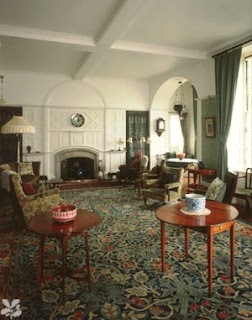
“I opened the doors and windows of America and let the air and sunshine in,” Elsie de Wolf exclaimed. The early twentieth-century interior decorator is often credited for being the first to toss out the dark and heavy gloomy Victorian palette to make way for a lighter and brighter scheme.
But was she really the first to brighten the Victorian interior?

Philip Connard (1875-1958), May Morning, late 19th century, Musee d'Orsay
The mid-nineteenth century saw an increase in concern about health and hygiene. Most middle class homes included a ‘sick room’ for use when members of the household were ill. The decoration of these rooms, suggested by household manuals, was for the wall paper to be subdued (preferably the walls to be white washed), the textiles simple and the crockery bland. Air and circulation were mandatory. Nothing in the room was to excite or disturb a feverish patient.

Félix Vallotton, The Sick Girl, 1892 (Private collection)
Dust retaining surfaces and heavy draperies were being eased out towards the end of the century, while beds made of polished oak, brass or cast iron were being brought in. They did not harbor dust or mites and could easily be cleaned. After all, de Wolfe suggested the use of white painted brass beds in one’s home, as hospitals did. All this, she argued, helped to allow for more air, light and space.
Catherine Beecher, an important advocate of the systematization of housework and the education of women, suggested the need for light and bright kitchens, and whenever possible to wash the walls with white paint.
By the turn of the twentieth century, the attraction and influence of the Arts and Crafts movement was powerful. The British influence reached almost every Western nation, especially in America. The Arts and Crafts movement wasn’t all about handiwork, the use of oak wood with exposed mortise and tenon joints, and a dusky color palette. There were architects and designers who, long before de Wolfe began to practice, believed in her value of “light, air and comfort” as they opened up space and painted walls white.

William Morris’ summer home in Kelmscott Manor.
Though Elsie de Wolfe detested her dark childhood bedroom with walls clad in a William Morris design, I wonder if she would have disapproved of the Kelmscott Manor drawing room Morris redecorated with his wife, Jane, in 1871. They painted the walls white and chose simple white wool drapes. They also upholstered the furniture with a pattern on a calm blue ground he created for Morris & Company.

First floor drawing room, Red House
Prior to designing the interiors of their country get-a-way, Morris commissioned friend and architect Philip Webb to design their first home when he was newly married. Red House was completed in 1860. Although the style of Red House was based on a medieval theme and wrought with subtle medieval details, it is comparatively light and airy with an open floor plan and many white painted walls.

Drawing room in Standen. (image from The National Trust.)
Philip Webb designed a number of English country houses. Many of his interiors had simple white-painted paneling -- much in contrast to the Victorian obsession of dark color palettes and rooms filled with clutter. A Wilshire house, Clouds (1881-1891), also designed by Webb included white walls and white painted plaster and woodwork with just a simple fireplace.

English architect CFA Voysey designed his own living room in The Orchard (1900) completely clutter-free. The interior space is very simple: he covered the walls with a violet fabric just to eye level then painted everything above white. The tiles around the fireplace hearth are a pale green. Though he did not align himself with modernists of his time, to our eyes this room is fresh, light and very modern.
Arguably, two designers who really let the air and sunshine in are Charles Rennie Mackintosh and Margaret Macdonald Mackintosh.

The Mackintoshes married in 1900 and moved into a flat in Glasgow decorating it in their own very unique language. Above is their studio drawing room – clear, calm and bright – this room is certainly the opposite of most dark, cluttered interiors so prevalent of the time.

The Mackintosh’s bedroom: walls, ceiling and furniture were all painted white with white drapes surrounding the white bed – designs stenciled on the frieze of the bed were repeated in embroidery on the bedcover and the valance (not shown). This all-white room was a radical departure of the time not only in color, but form and style.

The bedroom of The Hill House.
Designed in 1902 and completed in 1904, The Hill House was designed for the family of Glasgow publisher Walter Blackie in Helensburgh, Scotland.
The Mackintoshes understanding of spatial relationships, ability to deliver a clearly defined program, as well as create a unique repertoire of forms, colors, and exquisite details were truly a groundbreaking vision of the time. Their rooms were bright, airy and spacious and their furniture creations light and finely crafted. Their spaces weren’t simply decorated, they were designed.

The bedroom of The Hill House, expanded view.
Margaret was an incredibly talented artist and had great influence on her husband’s work. Exactly how closely the two collaborated on the interiors is unclear, but often her initials were added to his drawings and renderings. Particularly notable are her gesso murals and embroidered panels she alone created. One wonders if she lived in a country where her vision was more acceptable, wasn’t hampered by her disagreeable husband who lost clients, had the important social connections and the ability to self-promote what work we would be seeing?
Top image: Elsie de Wolfe's dining room on Irving Place second remodel c. 1900; Last five images: CFA Voysey from John Pile’s History of Interior Design, Mackintoshes Blake, Essential Charles Renie Mackintosh and Swinglehurst, CRM.
 The usual resolutions and goals set for the start of a new year are falling a bit flat for me this time around. Each year I make them -- some are met, others forgotten and a few adjusted -- and the following year I make them again. I had reasonable hopes for 2009, but the year ended with a loud, crashing thud. This New Year's Eve, I'm tip-toeing cautiously into 2010 carrying with me no resolutions, no goals, and no expectations.
The usual resolutions and goals set for the start of a new year are falling a bit flat for me this time around. Each year I make them -- some are met, others forgotten and a few adjusted -- and the following year I make them again. I had reasonable hopes for 2009, but the year ended with a loud, crashing thud. This New Year's Eve, I'm tip-toeing cautiously into 2010 carrying with me no resolutions, no goals, and no expectations. 






















































